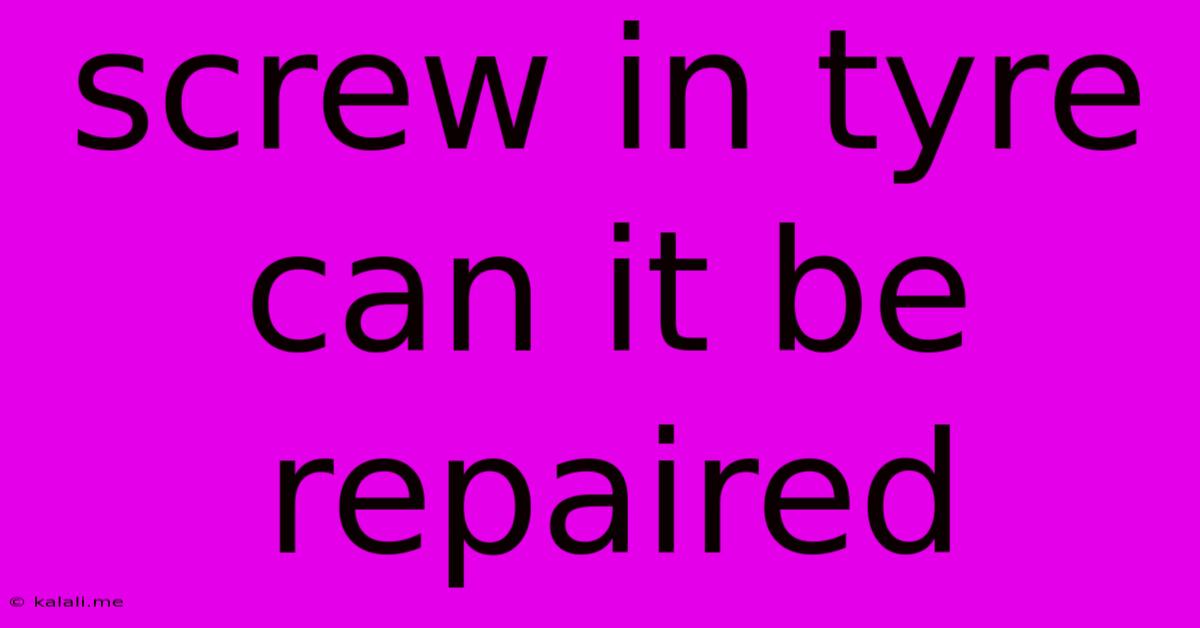Screw In Tyre Can It Be Repaired
Kalali
May 21, 2025 · 3 min read

Table of Contents
Can a Screw in Your Tire Be Repaired? A Comprehensive Guide
A screw in your tire is a frustrating experience, leaving you stranded and wondering about the repair possibilities. This comprehensive guide will walk you through determining whether your tire is repairable, the repair process, and when replacement is necessary. We'll cover everything from assessing the damage to understanding the long-term implications of a tire repair.
Assessing the Damage: Where Did the Screw Strike?
The location of the screw is paramount in determining repairability. Several factors influence this decision:
- Tread Depth: Screws embedded in the tire's tread area are generally repairable. However, the depth of penetration matters significantly. If the screw penetrates beyond the tread's depth into the tire's sidewall, it is usually unrepairable.
- Sidewall Damage: Damage to the sidewall is almost always unrepairable. The sidewall is the tire's structural support, and any damage compromises its integrity. Even a small puncture in the sidewall can lead to a blowout. Never attempt to repair a sidewall puncture.
- Screw Size and Type: A small screw is generally easier to repair than a large nail or other sharp object. The type of screw (e.g., wood screw, sheet metal screw) also impacts the repair's feasibility. A jagged screw can cause more extensive damage than a smooth one.
- Proximity to the Tire's Shoulder: The shoulder area is the section where the tread meets the sidewall. Damage in this area is more complex to repair and often requires replacement.
The Repair Process: A Step-by-Step Guide (for tread punctures only!)
If the screw is in the tread and not too deep, a repair might be possible. However, this is a job best left to a tire professional. Improper repair can lead to a dangerous blowout. That being said, understanding the process is helpful:
- Removing the Screw: The screw should be carefully removed using pliers. Avoid twisting the screw, as this can worsen the damage.
- Inspection: The puncture is thoroughly inspected to determine the extent of the damage.
- Plugging the Hole: A tire plug is inserted into the puncture hole from the inside of the tire. This is done using a specialized tool.
- Patching the Hole: A patch is then applied to the outside of the tire to reinforce the repair.
- Inflation and Balancing: The tire is inflated to the correct pressure and balanced.
When Tire Replacement is Necessary:
Even with a seemingly minor screw puncture, tire replacement is often necessary in these situations:
- Sidewall punctures: As mentioned, these are never repairable.
- Deep Tread Punctures: If the screw penetrates too deeply into the tire, a plug and patch might not effectively seal the hole, leading to air leakage and potential failure.
- Multiple Punctures: If there's more than one puncture, replacing the tire is the safer option.
- Damage to the Belt or Carcass: Internal damage beyond the visible puncture can compromise the tire's strength. A professional inspection can reveal this damage.
- Older Tires: If your tire is approaching the end of its useful life, replacing it is advisable even with a repairable puncture. The added stress from the repair could lead to premature failure.
- Uncertainty: If you're unsure about the extent of the damage, a tire professional should make the final call.
Conclusion:
A screw in your tire doesn't automatically mean you need a new tire. However, proper assessment is key. Consult a qualified tire professional to determine the best course of action—repair or replacement—to ensure your safety and driving peace of mind. Remember, safety is paramount when dealing with tire damage.
Latest Posts
Latest Posts
-
What Axis Does The Dependent Variable Go On
May 21, 2025
-
How To Strip Paint From Plaster
May 21, 2025
-
What Is A Half Of A Quarter
May 21, 2025
-
How Long Does It Take For Wheat To Grow
May 21, 2025
-
No Water Coming Out Of Faucet
May 21, 2025
Related Post
Thank you for visiting our website which covers about Screw In Tyre Can It Be Repaired . We hope the information provided has been useful to you. Feel free to contact us if you have any questions or need further assistance. See you next time and don't miss to bookmark.